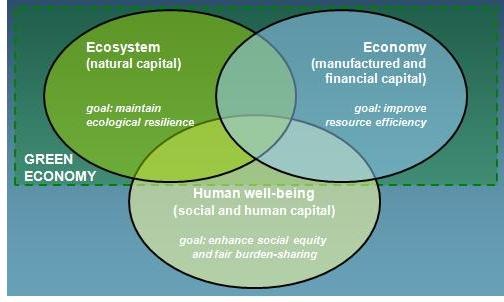Historically, of course, the trend has not been towards green growth. On the contrary, economic expansion has imposed ever greater demands on natural systems — both in terms of the amount of resources that we extract or harvest, and the volume of emissions and waste that we expect the environment to absorb and neutralise.
As is increasingly understood, this cannot continue indefinitely: the environment has natural limits in terms of how much it can provide and absorb.
There's no such thing as 'brown growth'
Consider the basic facts. If global GDP grows at 3 % annually then a century from now the world economy will be almost 20 times larger than today. Already, humans appropriate more than half the available freshwater and exploit most good quality soil resources. We are emitting ever more pollutants, greenhouse gases and waste. And we risk crossing critical environmental thresholds, leading to dramatic and irreversible damage to ecosystems.
When we reflect on the demands that we are already imposing on our ecosystems, it’s apparent that green growth isn’t just a preferable approach to economic development. On the contrary, in the long term it’s the only way to sustain economic growth. ‘Brown growth’ that destroys our natural systems can’t be justified by the apparent gains it offers. Ultimately, it will diminish our prosperity in every sense.
In contrast, the objectives of a green economy are to meet our needs — for food, transport, energy and so on — in a sustainable and equitable way.
Delivering a green economy: the twin challenge
Of course, understanding the concept of the green economy and its importance is only a first step. Key questions remain. What does a green economy look like? And how can we create a green economy in Europe?

The EEA’s flagship report, The European Environment: State and Outlook 2010 (SOER 2010), published in November 2010, provides some answers.
As described there, we essentially face a twin challenge. First, we need to focus on the economy, finding ways to increase our prosperity without increasing resource use and environmental impacts. Put simply, we need to become more resource efficient.
By itself, however, resource efficiency won't guarantee steady or declining resource use. After all, we could become more efficient but still put excessive demands on the environment. For that reason, to achieve sustainability we also need to focus on ecosystem resilience — the status, trends and limits of natural systems.
As SOER 2010 points out, there is a third element that needs to be included in discussions on resource efficiency and ecosystem resilience: human well-being.
This aspect is crucial for a variety of reasons. For one thing, the benefits we derive from the environment or the harms that we suffer due to degradation are not always reflected in prices and economic decision-making and thus require separate consideration. Equally important, there is a need to ensure an equitable distribution of the benefits (and also the costs) of the transition to a green economy
In balancing environmental, economic and social elements, the green economy concept evidently has much in common with the notion of sustainable development — albeit with a focus primarily on the environmental and economic aspects.
The green economy knowledge base
As explained above, a 'green' economy is one in which policies and innovations enable society to generate more of value each year, while maintaining the natural systems that sustain us. Essentially, it’s a pretty simple concept.
Unfortunately, translating the idea into reality is hugely more complicated. Clearly, it will require technological innovation. But it requires lots of other changes too — to the way we organise businesses; the way that we design cities; the way we move people and goods around; the way we live, essentially.
Effecting changes of this sort requires the engagement of all sectors, including policymakers, businesses and individual citizens. And that in turn implies the need for a mass of information to guide and inform decision-making.
The EEA was established to gather, interpret and communicate regarding the European environment in order to support informed decision-making. As such, the Agency has an important role to play in developing the knowledge base on the green economy.
This area of the EEA website will be developed through 2011, 2012 and beyond to highlight work by EEA and our partners at the national and international levels, explaining its relevance to the green economy debate.

Document Actions
Share with others